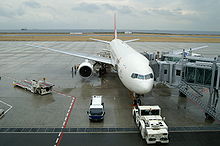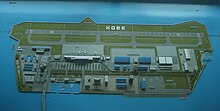Kobe Airport
| Kobe Airport | |
|---|---|

|
|
| Characteristics | |
| ICAO code | RJBE |
| IATA code | UKB |
| Coordinates | |
| Height above MSL | 7 m (23 ft ) |
| Transport links | |
| Distance from the city center | 8 km south of Kobe |
| Street | Hanshin - Motorways 3 and 5 via Port Island |
| train | Port liner |
| Basic data | |
| opening | February 16, 2006 |
| operator | Kansai Airports Kobe |
| surface | 156 ha |
| Terminals | 1 |
| Passengers | 3.1 million (2017) |
| Flight movements |
approx.27,736 (2017) |
| Start-and runway | |
| 09/27 | 2500 m × 60 m asphalt |
| website | |
| www.kairport.co.jp | |
The Kobe Airport ( japanese 神戸空港 Kobe Kuko ) is the domestic airport of the city of Kobe in Japan . According to Japanese law, Kobe Airport is a 3rd class airport .
Technical specifications
The airport is located about 850 meters south of the artificial harbor island Port Island and eight kilometers south of Sannomiya , the city center of Kobe, about five meters above sea level.
Construction began in September 1999 and commissioning took place on February 16, 2006.
To build the 272- hectare artificial island in Osaka Bay , 66 million cubic meters of rubble, eight million cubic meters of sand and 16 million cubic meters of rock were moved.
The runway is 2500 meters long and 60 meters wide in an east-west direction (about 265º), so that the entry lane runs exactly over the Akashi-Kaikyō Bridge , the departure lane over the northern tip of Awaji-shima . The new airport, which is to serve, among other things, disaster risk reduction, was built on an active earthquake fissure. The applied gravel compaction on the site protects against the expected soil liquefaction effect (see: Rokkō Island ) in the event of an earthquake.
business
The two-story terminal building on the north side has 17,000 square meters of floor space; From the entrance and exit of the Kobe-Kūkō-Eki Port Liners station to boarding , all stations for departing passengers are on the first floor. The arrival takes place on the ground floor. There is a viewing platform on the terminal roof.
The terminal, which is currently set up exclusively for domestic traffic, has four gates , and a total of handling areas are provided for:
|
|
In the first flight plan there are 27 flight movements each:
- 11 × Tōkyō-Haneda (seven times with " Skymark ")
- 4 × Kagoshima
- 4 × Naha
- 3 × Shin-Chitose ( Sapporo )
- 2 × Sendai
- 2 × Niigata
- 1 × Kumamoto
Japan Airlines and All Nippon Airways each operate 10 pairs of flights .
The largest aircraft is the Boeing 777 , other aircraft types are B737 , A320 , B767 and De Havilland DHC-8-400 .
In the first full calendar year 2007, with a seat occupancy rate of 65 percent, 2.96 million passengers used Kobe Airport. Compared to the previous year, this is about a ten percent increase. The freight volume was 21,952 tons, a good half of which was mail. In the comparable months of 2006, around a quarter more goods were handled.
Transport links
The airport is connected to Sannomiya, the center of Kobe, by the port liner. For this purpose, the existing route from Port Island was extended by three stations to the south. The total travel time is around 18 minutes.
There are around 750 parking spaces.
In addition to a taxi stand, there are also stops for limousine buses. The latter connect the Kobe airport with other cities and the Itami and Kansai airports .
There is also a high-speed ferry service that connects Kobe Airport with Kansai International Airport and the town of Sumoto on Awaji-shima (via Kansai Airport).
building-costs
The city of Kobe put the cost of the infrastructure in its report from autumn 2005 at 314 billion yen . Of this, the island construction and the connecting bridge account for 242 billion yen, the terminal, tower, radar system and weather station are listed with an additional 20 million euros (converted). The airport is funded by city bonds (210.8 billion yen), land sales from reclamation (67.7 billion yen), and government grants of 30.2 billion yen. The administration is incumbent on the operating company of the port of Kobe (神 戸 港埠 頭 公社), a company under public law, which is financed by interest-free and interest-bearing loans from the city of Kobe as well as income from port usage and landing fees. The plans assume a passenger volume of 3.19 million per year and estimate it to be 4.03 million in the year 2010. The broadcaster Yumiuri TV reported in February 2006 on new estimates of only 2.7 million flight passengers in the first year (16.2. until 31.12.), in fact it was 2.37 million. In the 2017 calendar year, 3.11 million passengers used the airport. 2011 only Skymark and ANA with the destinations Sapporo, Ibaraki, Tōkyō-Haneda, Nagasaki, Kumamoto, Kagoshima and Naha serve the Kobe airport; the utilization is still at 70 percent.
criticism
The citizens of Kobe had spoken out against the construction of the airport in numerous demonstrations and a collection of 310,000 signatures. The reasons for the rejection of the airport plans were the expected aircraft noise and a different assessment of the needs of the town hall, especially in view of the high costs. In space Kansai there are already two major airports Itami and Kansai . The latter has been considered to be in deficit due to its lower than expected utilization as a result of the long economic downturn in Japan since its commissioning in 1994: 24-hour operation and expansion to two runways were considered breakeven at Kansai Airport, neither of which has yet been reached. The Kobe airport will again create overcapacity and prove to be an economic bad investment, so the fears. Citizens are better served with improved connections to Kansai International Airport.
The city administration, on the other hand, referred to a study from 2002, according to which the number of passengers in the Kansai area rose by 3.3 percent annually to 23.69 million between 1994 and 2002 and will continue to increase at a rate of 2.2 to 2.8 in the future Percent is to be expected, so that a volume of 31.4 million is forecast for 2012. Itami urban airport is already reaching the limits of its requirements due to its location in the middle of residential areas: a maximum of 370 take-offs and landings per day and air traffic only between 7 a.m. and 9 p.m. The city hall of Kobe estimated the annual additional tax revenue from the new airport at 30 billion yen.
At the opening of the airport, the television reported problems with the landing: Due to unfavorable wind conditions from the side ( Rokkō-Oroshi downwind from the Rokkō ) it was only possible to fly to the airport from the west as planned in just over ten percent of the cases. For a safe landing, it is mostly necessary to fly over Osaka Bay, which affects the operation of Kansai Airport. The increase in local taxes as part of income tax in Kobe in 2006 is seen in connection with the costs of the new airport construction.
Others
In addition to the visitor terrace , the attractions of the airport island will be a new waterfront on the city side and an artificial beach, the so-called "lagoon", near the runway. Apart from the small landing stage, the airport island is surrounded by a small strip of shallow water for marine animals.
Web links
- Airport Official Homepage ( Japanese )
- The airport website of the city of Kobe with information on construction and costs (Japanese, latest images)
- The airport website of the city of Kobe with information on construction and costs (English, fewer updates than previous)
- Civil rights movement "Minato-Kobe wo mamoru Kai" (Japanese)
- Port company (Kobe Port Terminal Cooperation) (English)
- High-speed ferry schedule to Kansai Airport
Individual evidence
- ↑ a b Kobe Airport ( Japanese , PDF) MLIT . Retrieved September 14, 2018.
- ↑ Ministry of Land, Infrastructure, Transport and Tourism (English)
- ↑ Official statistics by months and financial years (April – March) (Japanese)





